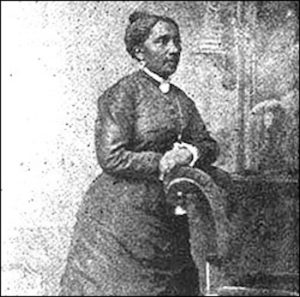
Elizabeth Jennings
*On this date in 1854, Elizabeth Jennings was refused a seat on a public Streetcar, setting off the first racial transportation lawsuit in America. It happened in downtown New York City.
In the 1830s, New York City barely reached 14th Street, but it was growing. By the 1850s, Manhattan stretched to 59th Street, and there were car tracks on most of the major avenues, from First to Eighth. This created a dilemma for black New Yorkers. In the 1830s and early 1840s, Blacks didn't use public transportation; the white driver decided if they could ride, and Blacks weren't welcome. With the motto "walk," community leaders suggested using other means. Bucking the segregated system was also dangerous. Drivers carried whips and used them to keep Blacks off. Threats of legal retaliation were laughed at.
By the late 1840s, there were special public buses on which Blacks could ride. They had large "Colored Persons Allowed" signs on the back or in a side window. But these vehicles ran infrequently, irregularly, and often not at all. In the 1850s, the horse-drawn streetcar on rails became a more common mode of transportation, competing with the horse-drawn omnibus in the city. (Elevated heavy rail, the next new model in the city, did not go into service until 1869.) Like the omnibus lines, private companies owned the streetcar lines, and their owners and drivers could refuse service to passengers.
Jennings was a 24-year-old Black schoolteacher on her way to the First Colored Congregational Church on Sixth Street and Second Avenue, where she was to perform as the organist. She was running late and boarded a Third Avenue Railroad Company streetcar at the corner of Pearl and Chatham Streets. The conductor ordered her to get off. When she refused, the conductor tried to remove her by force. Eventually, with the aid of a police officer, Jennings was ejected from the streetcar.
Jennings v. Third Ave. The railroad was filed in 1855. Jennings filed a lawsuit against the driver, the conductor, and the Third Avenue Railroad Company in Brooklyn, where Third Avenue was headquartered. The law firm of Culver, Parker, and Arthur represented her. The firm’s 24-year-old junior partner, Chester A. Arthur, future U.S. President, handled her case.
In 1855, the court ruled in her favor. In his charge to the jury, Brooklyn Circuit Court Judge William Rockwell declared: Colored persons, if sober, well behaved, and free from disease, had the same rights as others and could neither be excluded by any rules of the Company nor by force or violence. The jury awarded Jennings damages for $225 (comparable to $5,000 to $10,000 in 2008 dollars) and $22.50 in costs. The next day, the Third Avenue Railroad Company ordered its cars desegregated.
The Third Avenue Railroad, one of the first four street railway companies franchised in the city, had operated only one year during the Jennings incident. The Jennings case was instrumental in establishing policy for a new service industry. A month after the verdict, a black man was refused admission to a car of the Eighth Avenue Railroad, another of the first four companies, and won a similar judgment against that company.
New York's public transit was fully desegregated by 1861. The incident sparked an organized movement among Black New Yorkers to end racial discrimination on streetcars, led by notables such as Jennings's father, Thomas, Rev. James W.C. Pennington, and Rev. Henry Highland Garnet. Frederick Douglass publicized her story, and it received national attention.